This is typically "transmodulation" or "crossmodulation" for some ...
Suppose the amplifier input characteristic is :
Vs: = a0 + a1 * vg + a2 * vg ^ 2 + a3 * vg ^ 3. For a diode ... exp (vg) can also be used...
(for example: a0 = 1; a1 = 1; a2 = 1; a3 = 1)
Suppose the signal (picked up by the finger) at the input of the amplifier (very bad) is:
vg: = sin (x) + sin (y) * sin (z);
x = 50 is the frequency of the local network,
y = 1000000 is the carrier of the "received" signal,
z = 1000 is the modulation of the carrier (the useful information);
Calculating then the spectrum of signal generated by the non linear function :
The "received signal" is therefore (sorry for the length ...) = -. 500 * sin (998950) -. 500 * sin (1001050) +. 500 * sin (1000950) +. 125 * cos (1998000) -. 250 * cos (2000) -. 250 * cos (2000000) +. 125 * cos (2002000) + 1.53 * cos (999000) -. 250 * sin (150) + 2.50 * sin (50) -. 375 * sin (2000050 ) +. 375 * sin (1950) -. 375 * sin (2050) +. 375 * sin (1999950) +. 313e-1 * cos (2997000) -. 313e-1 * cos (3003000) -. 500 * cos (100) + 1.75-.188 * sin (1997950) +. 188 * sin (2002050) -. 188 * sin (2001950) -. 938e-1 * cos (997000) -. 938e-1 * cos (2999000) + .375 * cos (1000900) +. 375 * cos (1001100) +. 938e-1 * cos (1003000) +. 938e-1 * cos (3001000) +. 188 * sin (1998050) -. 375 * cos (998900 ) -. 375 * cos (999100) -1.53 * cos (1001000) +. 500 * sin (999050).
In this result; only usefull the values in the sines between 20 Hz and 20 kHz !!!
There are therefore only two signals centered on 100 Hz and 2000 Hz.
So you hear the distorted "50 Hz" ... and the carrier information centered on "2000 Hz" and not 1000 Hz, so also distorted but audible.

